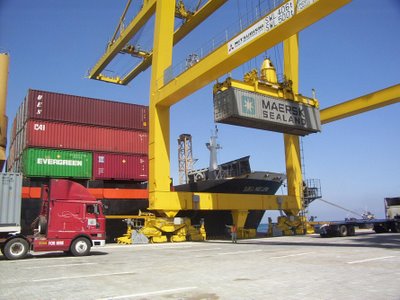
VILLANUEVA, MISAMIS ORIENTAL (MIKE BAÑOS / June 16) - Shipping traffic is finally picking up at the Mindanao Container Terminal (MCT) after international shipping lines serving Northern Mindanao are slowly but surely moving their business to the multi-billion peso facility.
The Phividec Industrial Authority (PIA) which administers the MCT says they are now receiving regular port calls from three shipping lines: Maersk-Filipinas, NMC Container Lines and Hamburg-Sud.
Maersk calls on the port every Wednesday, while NMC ships drop in every Tuesday, Thursday and Sunday. Hamburg-Sud calls only once every two months but will soon be joined by Lorenzo Container Shipping Corporation (Lorcon) which will be calling twice a week.
Container traffic in the MCT so far has been mostly contributed by NMC which regularly ships domestic cargo to Cebu and Manila.
PIA sources said they are still negotiating with American President Lines (APL), probably the largest volume shipper among the foreign shipping lines now calling on the region, since it primarily serves Del Monte Philippines Inc. which has its own port at its cannery in Bgy. Bugo, this city.
The MCT has been identified as a Mindanao flagship project of Mindanao, one of the key infrastructures needed to jump start the island's potential into reality. With a rated capacity of only 1.8 million metric tons (MT), the Cagayan de Oro base port at Macabalan already breached its maximum capacity
Considering the existing capacity of the Cagayan de Oro Baseport is only 1.8 million metric tons (MT), it is considered to have already breached its saturation point in 2002 when cargo throughput reached 2.79 million MT.
The MCT was conceived to fill the supply gap for an efficient cargo handling facility with its state of the art facilities and cargo handling equipment, capable of unloading one container van in about 2.5 minutes compared to 10 minutes for an ordinary port. It has been designed to be exclusively operated for fully-containered and semi-containerized domestic and foreign vessels and has an annual capacity of 270,000 TEUs for its first phase.
With the MCT, cargo can be efficiently shipped to and from its location at the Phividec Industrial Estate in Villanueva, Misamis Oriental, as well as those to and from other key growth centers in Mindanao, to the Brunei, Indonesia, Malaysia, Philippines East-Asia Growth Area or the BIMP-EAGA Region, as well as the Asia-Pacific Region.
The bulk (85%) of the MCT's US$ 85.34 million (Php 3.24 Billion) capital cost was funded by the Japan Bank for International Cooperation (JBIC) with the balance financed by PIA.
Despite the increasing containerized cargo traffic at the MCT, data from the Philippine Ports Authority (PPA) Northern Mindanao District Office shows total ship calls in region 10's public and private ports still fell 2.54 percent to 31,728 from 32,729 2004. Growth in cargo traffic last year was flat (22,667,638 metric tons in 2004 vs. 22,814,783 MT in 2005 while total passenger traffic shrunk 6.68 percent to 6,607,219 compared to 7,079,894.
This trend has been carried over to the first quarter of 2006, with total ship calls falling 2.09% to 7,116 compared to 7,268 for the same period last year. Overall cargo traffic for the first quarter dropped a hefty 20.96 percent to 4,508,960 MT, driven by the 26.65 percent drop in foreign cargo throughput (2,628,296 MT) and 11.36 percent decrease in domestic cargo traffic (1,880,664). Total passenger traffic likewise dropped 11.42 percent to 1,271,749 from 1,435,690 for the same period last year.
Participants to the Quarterly Regional Economic Situationer (QRES) hosted by the National Economic and Development Authority (NEDA) Region 10 office last June 8 noted foreign ship calls and trade in the government-owned base ports of Cagayan de Oro, Iligan and Ozamiz have decreased mainly due to the transfer of Maersk to the MCT.
Other factors attributed to the decrease in foreign cargo traffic included the significant drop in imported dairy products and absence of any scrap metal exports during the period. Although two additional inter-island vessels now call regularly on Iligan port, there are still no foreign vessels calling on it.
In contrast, inbound and outbound foreign cargo throughput in private corporate ports within the jurisdiction of the Port Management Offices (PMOs) of Iligan and Ozamiz were attributed to the increased exports of coconut oil and copra pellets from the ports of Granexport Manufacturing Corp. and San Miguel Corporation and copra cake from TMOMI.
There were no exports of cold rolled steel sheets, however, from Global Steel Works International, Inc. (formerly National Steel Corporation or NSC) for January and March, 2005. This commodity accounted for 11.33 percent of the region's US$541.424-million total exports in 2005, ranking third among the region's top ten exports behind crude coconut oil ( 23.92%) and canned pineapple products (15.78%).
"mike_banos_2000@yahoo.com>Link

No comments:
Post a Comment